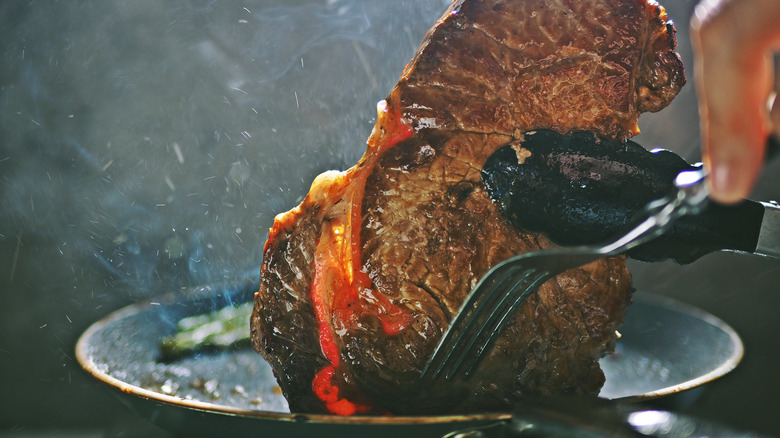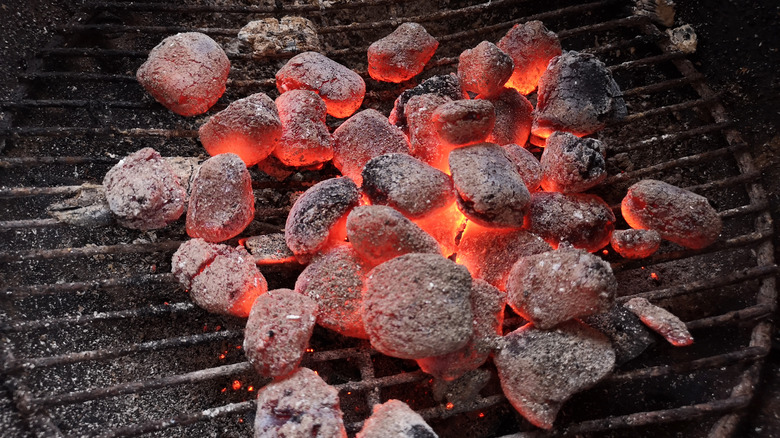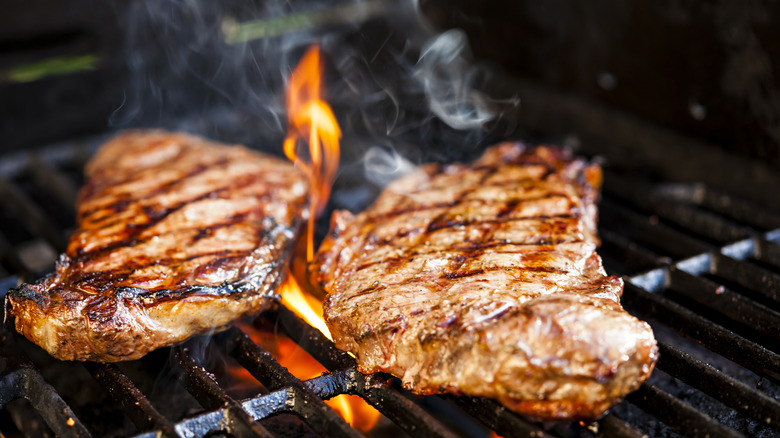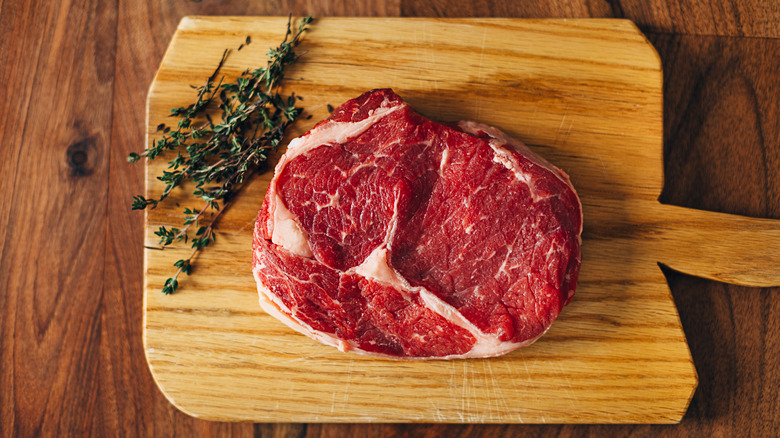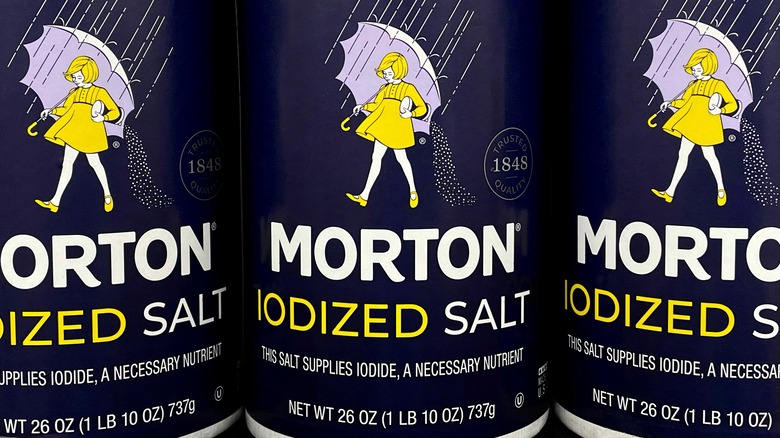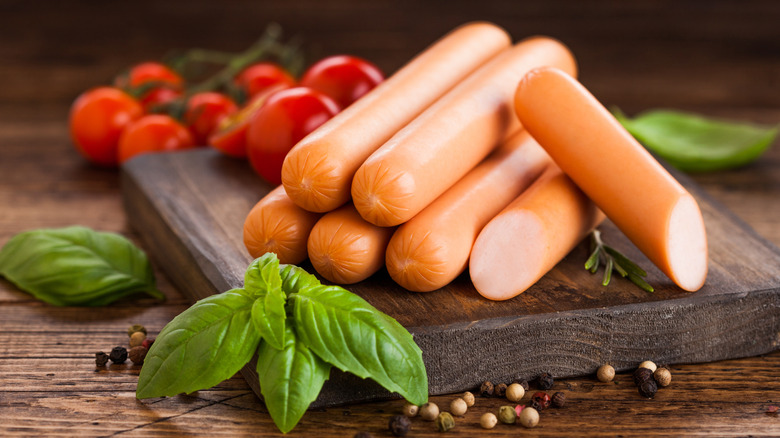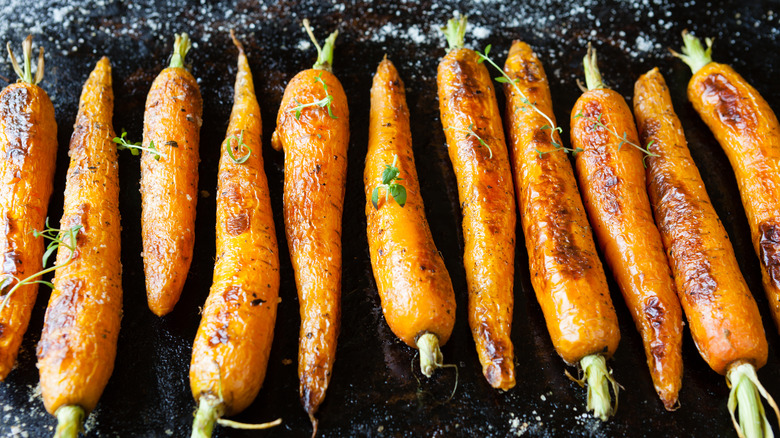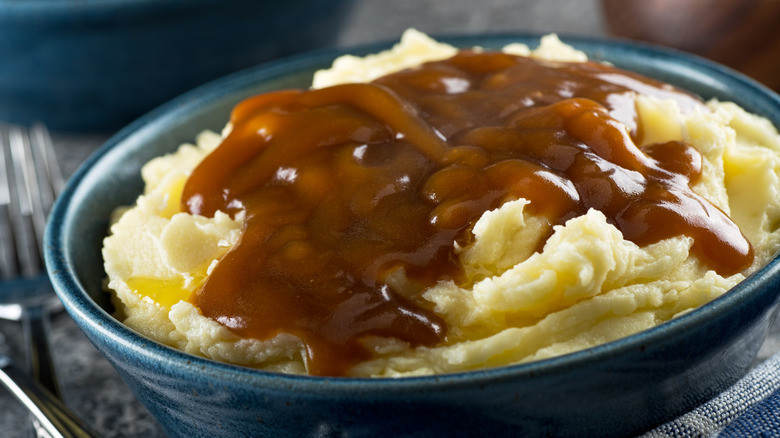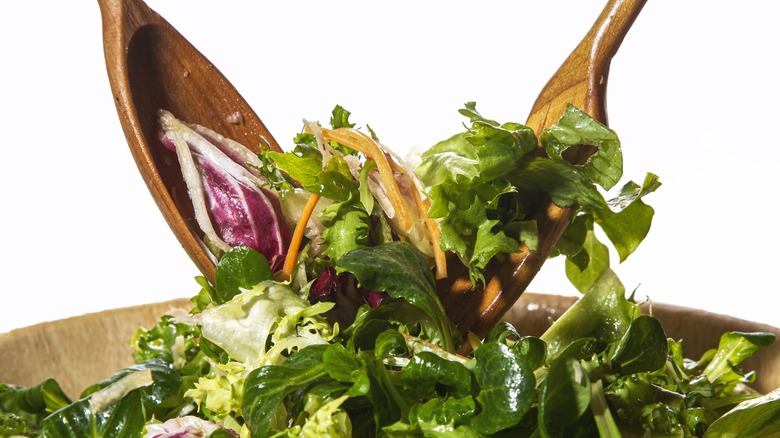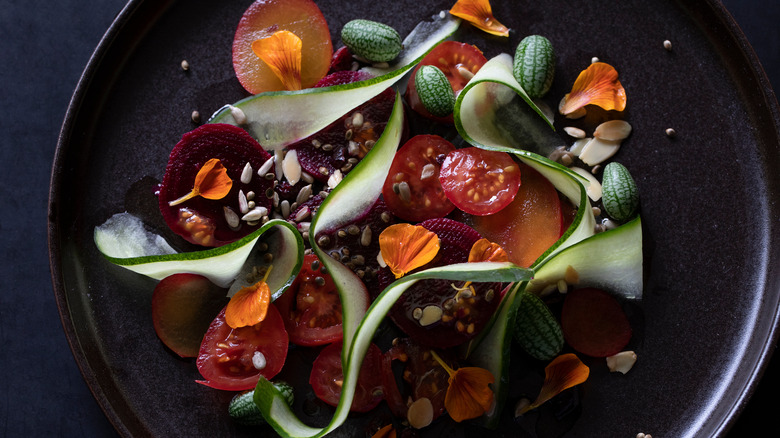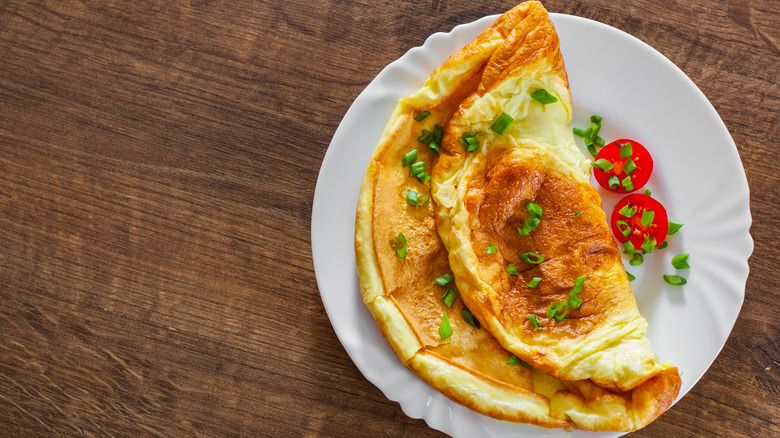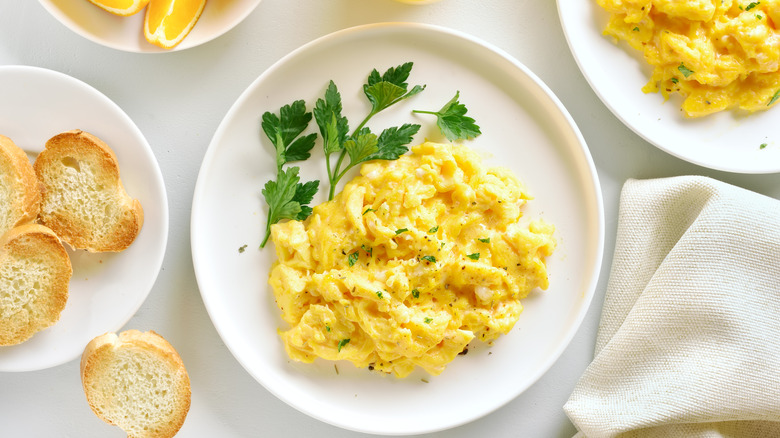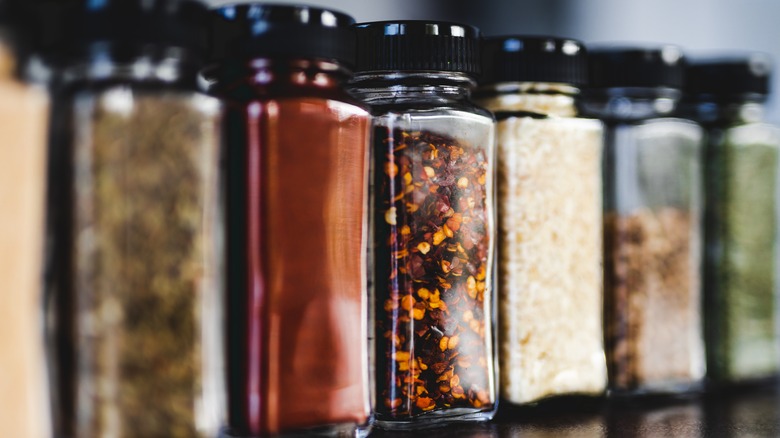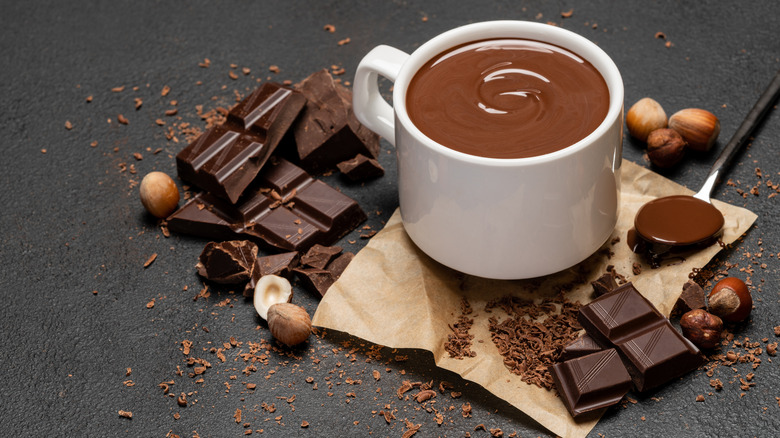Wolfgang Puck's 14 Best Cooking Tips For Home Chefs
Wolfgang Puck is one of the most recognizable names in the modern culinary world. The celebrity chef began his culinary empire in 1982 with the opening of Hollywood's Spago and has since expanded his portfolio to over 30 restaurants around the globe.
Puck grew up in Austria and started his culinary journey as an apprentice before immigrating to France to work at Maxim's. He moved to the United States at the age of 24 to work at Indianapolis' La Tour before settling in California in 1975 (via Wolfgang Puck). Puck is the only chef to have won the James Beard Foundation Award for Most Outstanding Chef twice. In 1998, Puck and his partner Carl Schuster opened Wolfgang Puck Catering, which has since catered high-profile events, including the Governor's Ball, Academy Awards, film premiers, and presidential galas.
Puck has published several cookbooks and stars in his own Food Network show. Outside of sharing his jaw-dropping fine cuisine pizza recipes with his high-end clientele, Wolfgang Puck also offers advice to home cooks looking to turn their recipes into something spectacular. Here are some of Wolfgang Puck's best pieces of advice and hacks for home cooks.
Sear room-temperature steak on wood or charcoal
Wolfgang Puck is quite the grill master. In one of his TikTok videos, he revealed that he only sears room-temperature steak — never a frozen steak. After the steak is at room temperature, Puck recommends liberally seasoning both sides of the steak and adding a bit of oil on both sides. Then, he places the steak on a firewood and charcoal grill for optimal flavor and tastiness.
Puck's aversion to grilling frozen steaks might be warranted. When you grill a frozen steak, you'll get a deliciously crisp exterior, but the extreme temperature difference will cause the inside of the steak to firm up and tighten. At 140 F, ThermoBlog notes that the steak will develop a gray band around the exterior of the steak rather than a solid pink color throughout. If you have to grill a frozen steak, ThermoBlog recommends using a thick cut of meat as well as indirect heat.
Additionally, there is some science behind cooking over charcoal and firewood versus a stovetop. According to the Texas Oven Company, wood-fired food (such as steak) both tastes and smells different than food cooked on a stove or an oven. This is because as the wood burns, it breaks down cellulose and releases two chemical compounds — guaiacol and syringol — which trigger both our nasal receptors and our tastebuds to something delicious. Gas and electric appliances simply cannot produce the same result because there isn't any cellulose to break down in the first place.
Light charcoal briquettes an hour before grilling
Yes, those little charcoal discs have a name: briquettes. Per Smoked BBQ Source, briquettes are made from sawdust and leftover wood with several additives mixed in. The briquettes burn longer than lump charcoal and maintain temperature for a longer period — which makes them ideal for grilling, or at least Wolfgang Puck thinks so. Puck recommends lighting charcoal briquettes at least an hour before you plan to grill any food over them. This means that you'll be grilling over hot coals rather than a direct flame. Grilling over a direct flame isn't always ideal because you may inadvertently singe your vegetables, fish, or steak.
You can further control the heat of your grill by placing three-quarters of the coals on either side of the grill. Another option is to make a ring with the coals to create a center area of indirect heat over which you can grill the foods you don't want to sear. It's a great approach for vegetables and fresh fruit, such as peaches.
Start searing steak at a high temperature
Wolfgang Puck has some serious opinions about steak. The chef starts his steak off with the temperature "as high as it can go" to develop the perfect crusty sear before turning the temperature down to finish the steak off. There are numerous methods for finishing steak, including in the oven or over low heat on the stovetop. Cast iron skillets are one of the preferred vessels for searing and finishing steak because the iron holds onto the heat better than less conductive materials — plus, you can bring it up to a high enough temperature to sear the meat, then lower the ambient temperature to finish the inside.
Some chefs don't abide by Puck's method and instead reverse sear their steaks by bringing a cold pan up to temperature while the steak is in it. Although it takes much more time to perfect, this method results in a splash-free space and requires no oil. While this approach may not meet Wolfgang Puck's standard, it does mean less cleanup for the home cook.
Let your steak rest before grilling
It's pretty obvious that Wolfgang Puck knows a thing or two about meat. He recommends seasoning the meat and letting it rest for at least an hour before grilling. Seasoning your steak perfectly involves adding enough salt to visually see a layer of salt crystals all over its exterior. Although it might seem like overkill to put so much salt on your steak, remember that you can't season the interior of the steak. A good rule is to use no less than ¾ teaspoon of salt per pound of beef.
Besides adding a delicious flavor to the steak, salt is an important tenderizing agent in crafting a delicious steak. The salt draws out the moisture in the meat and creates a brine that is reabsorbed into the steak as its cooking (via Criollo Grass Fed Beef). The removal of the moisture on the outside of the steak also aids in the Malliard reaction, which produces the perfect brown hue that makes your steak look all the more appetizing once it's on the plate.
Skip iodized salt
All types of salt are not created equally, and Wolfgang Puck is adamant about the salt he uses. The chef sticks to using sea salt or fleur de sel in his cooking and has vehemently expressed his dislike for iodized salt (also known as table salt). Puck argues that iodized salt is not the healthiest choice and also doesn't provide the same amount of flavor as other options.
Are there any benefits to using iodized salt in cooking? You'll first have to understand what iodized salt is and what makes it different from every other type of salt you can buy. Iodine was historically added to table salt in the 1920s to prevent the growth of thyroid goiters in the population. However, GoodRx Health notes that iodine can be found in other foods like seaweed, yogurt, and cod, and the deficiency has been dramatically reduced since its introduction in the 1920s. From a seasoning perspective, it is best to avoid using iodized salt on steak because it has more weight-to-volume than large grain salts, meaning that you can easily over-salt your food.
Elevate your hot dogs with cheese and bacon
The Austrian native has a few tricks up his sleeve when it comes to the classic hot dog. One of Wolfgang Puck's favorite ways to prepare hot dogs is by making the wiener würstchen of his childhood.
Wiener würstchen is a European version of the American hot dog and is usually made with a mix of beef and pork. Puck makes his wiener würstchen special by slicing the hot dogs down the middle and stuffing the sausage with Gruyere cheese. He finishes the dish by wrapping the meat with bacon, roasting the sausages, and serving them on a toasted bun with a side of horseradish sauce. The horseradish sauce is the perfect blend of spicy horseradish, mayonnaise, sour cream, and seasoning.
After you try this method of making hot dogs, you won't ever go back to your regular ol' ballpark frank with a squirt of ketchup and mustard.
Allow individual ingredients to shine
Wolfgang Puck is well-versed in many ingredients and cooking styles. He took a lot of his cooking philosophy from his mother, who was a fan of making delicious meals with simple ingredients. As a young chef, Puck's mother advised him to "use five or six ingredients and take out something." He compares it to editing, and Puck prides his style on highlighting the simplicity behind ingredients rather than creating something too complicated that blurs the clear lines of texture and flavor.
Home cooks should be challenged to elevate the flavors of ingredients as nature intended. One of our favorite examples is roasted carrots with chili oil, almonds, and apricot jam. You're not overtly changing the texture of the carrot but instead adding to its texture by flavoring it with hot chili oil and salty almonds. Cooking is all about integrity, and keeping your ingredients as real as possible is a pivotal piece of advice Puck learned at a young age.
Add brown butter to mashed potatoes
Mashed potatoes are a delicious staple on the dinner table, but Wolfgang Puck has a piece of advice to make your mashed potatoes all the more incredible. The chef adds brown butter to mashed potatoes in a TikTok video to add caramelized flavor to his spuds. Browning butter involves cooking butter over heat to remove some of the moisture and concentrate the buttery notes that make butter so delicious. Cooking down the butter also concentrates and browns the milk solids, which provides a nutty undertone to the butter.
Browning butter at home is simple and only requires a lightly-colored pan and your favorite butter. The lightly-colored pan allows you to observe the caramelization as its happening and reduces the risk of burning the butter. You'll want to heat the butter over medium heat and swirl it frequently. Small brown flecks are signs that your butter is browning; remove the butter from the pan once you start to smell a nutty aroma.
Use a sheet pan to evenly distribute salad seasoning
Making sure your salad has an even distribution of seasoning can be difficult — especially when your bowl is small. Wolfgang Puck has an unconventional tip to ease your salad woes, and it involves grabbing a sheet pan from your kitchen cabinet. The chef recommends seasoning salad on a sheet pan. Evenly layering greens on the pan before adding salt, pepper, and your favorite dressing allows the seasoning to seep into every crevasse of lettuce, arugula, or whatever salad base you choose. You can also use this trick with salad toppings since every cherry tomato and pepper deserves to be the star of the show.
If you don't want to handle the pieces of lettuce and topping with your hands, place a layer of parchment paper down on the pan first. That way, you can just lift the parchment and funnel it back into your serving bowl.
Use flowers to make your plate look beautiful
Wolfgang Puck doesn't just think food should taste good; it should also be beautiful to look at. The chef is known to use several types of edible flowers to adorn his dishes and ventures to use these bursts of colors outside of salads as well. His salads often feature bright hues of purple and red from rose petals and violets, while his masculine steaks are contrasted with yellow and orange calendula petals.
There are some precautions home cooks need to take before they pick petals from their garden for their next dish — especially because not all flowers are edible. Chive flowers are one bright purple addition to your plate that pairs well with yellow and brown-colored foods. Or consider a flower with a bit more flavor, like a red-purple hibiscus or dainty lavender. Who knew being a home cook required a degree in art too?
Learn how to make a good omelet
What is the best way to evaluate a chef's competency in the kitchen? Wolfgang Puck thinks it's sticking to a simple but technically challenging recipe that gauges a chef's ability to moderate ingredients, temperatures, and techniques. He tests all of his prospective chefs with an omelet-making entrance exam to ensure they can master the breakfast dish, which he argues is perfect because it doesn't have sauces to "mask the imperfections."
Puck learned to make omelets in France, so he can appreciate the perfect omelet's soft inside and crisp exterior. If you want to tune up your omelet-making skills, we recommend starting with a rubber spatula and salted butter. Then, constantly shake and shimmy the eggs to prevent the curds in the median that are neither too dry nor wet. You should also aim for an omelet that is slightly underdone since overcooking even by a few minutes has the potential to ruin the texture of the breakfast classic.
Always season your eggs
Wolfgang Puck has a penchant for eggs, so it's no surprise that the chef has a favorite way to prepare eggs for his morning plate. Puck believes scrambled eggs are deceptively easy to make because you have to cook the protein low and slow. In a TikTok video, Puck also shared that he always seasons his eggs while he's cooking so he doesn't forget to once the eggs are ready to be served.
Outside of the standard salt-and-pepper seasoning, Puck has a clear favorite garnish for his scrambled eggs: white truffles. For those who haven't had the opportunity to try this ingredient, we can confidently say that you're likely not the only one. White truffles can sell for upwards of $4,000 per pound (via Bloomberg) and only last a few days before spoiling. When it comes to the basic breakfast scramble, we'll stick to salt, pepper, and maybe a bit of garlic powder.
Toast your spices for better flavor
As a chef, Wolfgang Puck is all about elevating the simplest of flavors into something spectacular. He loves working with spices and has a soft spot for spicy ginger, per MasterClass. But Wolfgang Puck's best tip for home cooks around spices involves the oven or a saucepan.
Puck recommends toasting peppercorns before cooking with them. This releases some of the oil in the peppercorns and makes the spice much more flavorful. He uses this technique in his restaurant kitchens for cumin and coriander, too. To toast peppercorns at home, add the whole peppercorns to a heavy skillet over medium heat for three to five minutes. If you're using this technique, be sure to remove the peppercorns from the heat when you start to smell the peppery aroma. Otherwise, you'll end up with bitter and burnt notes from your spices rather than enticing, warm, and nose-itchingly good ones.
Take the time to make a great hot chocolate
Wolfgang Puck has some fond memories of his childhood, including his favorite beverage: hot chocolate. When Puck was growing up in Austria, he didn't have access to modern, ready-made Swiss Miss powder. Instead, his mother made hot chocolate using milk from the farm that he skimmed himself and tempered chocolate.
For the novice dessert-goers among us, tempering is a process that involves heating chocolate with cacao butter to change its crystal structure (via Alpha Foodie). The result is chocolate that is snappy, glossy in color, and holds its shape at room temperature. If you've ever had designer hot cocoa bombs, you've probably experienced the taste of properly melted and tempered chocolate.
In reality, most folks will stick to the powdered hot cocoa mix when it comes to hot chocolate. However, Puck's childhood sentiments remind us that it's important to enjoy the simple things in life and take time to elevate the textures and flavors of all of our ingredients — sweets included.

